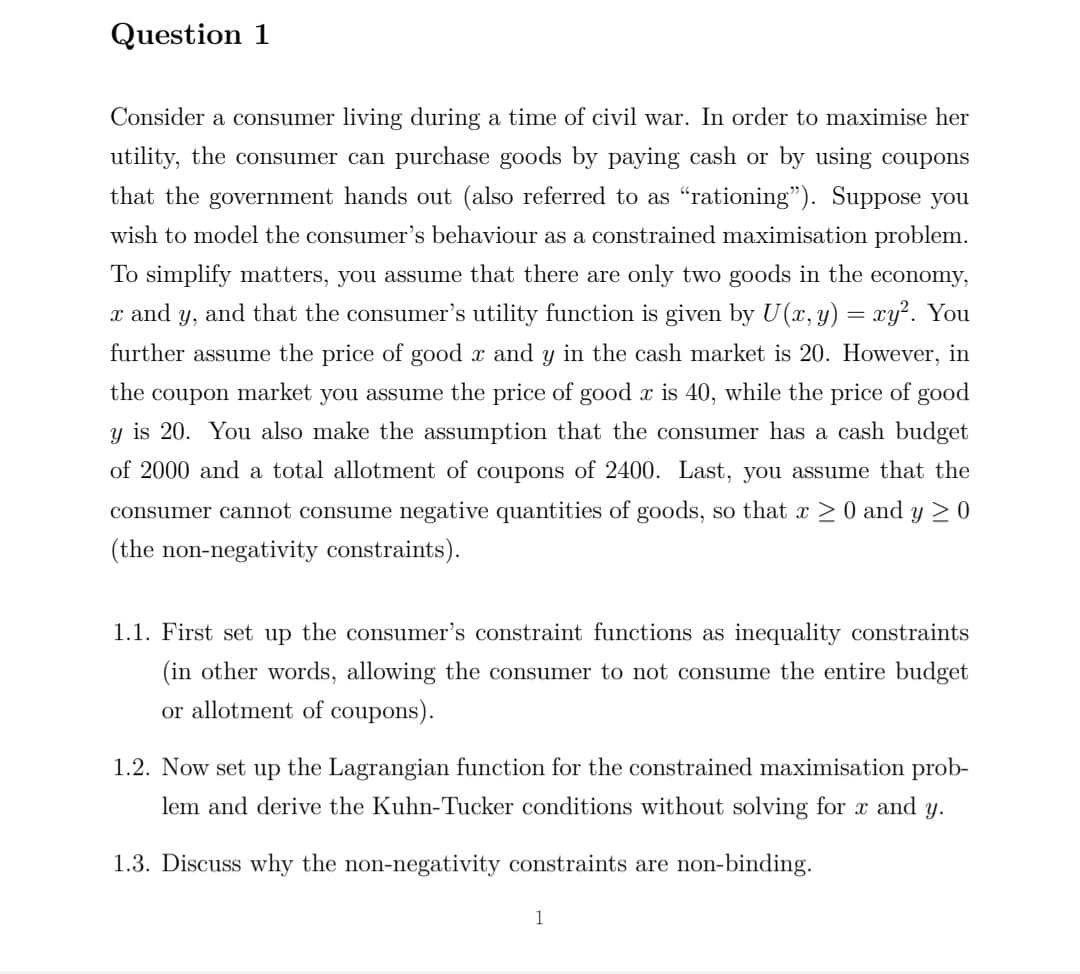Consider a consumer living during a time of civil war. In order to maximise her utility, the consumer can purchase goods by paying cash or by using coupons that the government hands out (also referred to as “rationing"). Suppose you wish to model the consumer's behaviour as a constrained maximisation problem. To simplify matters, you assume that there are only two goods in the economy, x and y, and that the consumer's utility function is given by U (x, y) = xy?. You further assume the price of good x and y in the cash market is 20. However, in the coupon market you assume the price of good r is 40, while the price of good y is 20. You also make the assumption that the consumer has a cash budget of 2000 and a total allotment of coupons of 2400. Last, you assume that the consumer cannot consume negative quantities of goods, so that x 20 and y 20 (the non-negativity constraints).
Consider a consumer living during a time of civil war. In order to maximise her utility, the consumer can purchase goods by paying cash or by using coupons that the government hands out (also referred to as “rationing"). Suppose you wish to model the consumer's behaviour as a constrained maximisation problem. To simplify matters, you assume that there are only two goods in the economy, x and y, and that the consumer's utility function is given by U (x, y) = xy?. You further assume the price of good x and y in the cash market is 20. However, in the coupon market you assume the price of good r is 40, while the price of good y is 20. You also make the assumption that the consumer has a cash budget of 2000 and a total allotment of coupons of 2400. Last, you assume that the consumer cannot consume negative quantities of goods, so that x 20 and y 20 (the non-negativity constraints).
Practical Management Science
6th Edition
ISBN:9781337406659
Author:WINSTON, Wayne L.
Publisher:WINSTON, Wayne L.
Chapter2: Introduction To Spreadsheet Modeling
Section: Chapter Questions
Problem 20P: Julie James is opening a lemonade stand. She believes the fixed cost per week of running the stand...
Related questions
Question

Transcribed Image Text:Question 1
Consider a consumer living during a time of civil war. In order to maximise her
utility, the consumer can purchase goods by paying cash or by using coupons
that the government hands out (also referred to as “rationing"). Suppose you
wish to model the consumer's behaviour as a constrained maximisation problem.
To simplify matters, you assume that there are only two goods in the economy,
x and y, and that the consumer's utility function is given by U(x, y) = xy². You
further assume the price of good x and y in the cash market is 20. However, in
the
coupon market you assume the price of good x is 40, while the price of good
y is 20. You also make the assumption that the consumer has a cash budget
of 2000 and a total allotment of coupons of 2400. Last, you assume that the
consumer cannot consume negative quantities of goods, so that x >0 and y > 0
(the non-negativity constraints).
1.1. First set up the consumer's constraint functions as inequality constraints
(in other words, allowing the consumer to not consume the entire budget
or allotment of coupons).
1.2. Now set up the Lagrangian function for the constrained maximisation prob-
lem and derive the Kuhn-Tucker conditions without solving for x and y.
1.3. Discuss why the non-negativity constraints are non-binding.
1
Expert Solution
This question has been solved!
Explore an expertly crafted, step-by-step solution for a thorough understanding of key concepts.
Step by step
Solved in 2 steps

Knowledge Booster
Learn more about
Need a deep-dive on the concept behind this application? Look no further. Learn more about this topic, operations-management and related others by exploring similar questions and additional content below.Recommended textbooks for you

Practical Management Science
Operations Management
ISBN:
9781337406659
Author:
WINSTON, Wayne L.
Publisher:
Cengage,

Operations Management
Operations Management
ISBN:
9781259667473
Author:
William J Stevenson
Publisher:
McGraw-Hill Education

Operations and Supply Chain Management (Mcgraw-hi…
Operations Management
ISBN:
9781259666100
Author:
F. Robert Jacobs, Richard B Chase
Publisher:
McGraw-Hill Education

Practical Management Science
Operations Management
ISBN:
9781337406659
Author:
WINSTON, Wayne L.
Publisher:
Cengage,

Operations Management
Operations Management
ISBN:
9781259667473
Author:
William J Stevenson
Publisher:
McGraw-Hill Education

Operations and Supply Chain Management (Mcgraw-hi…
Operations Management
ISBN:
9781259666100
Author:
F. Robert Jacobs, Richard B Chase
Publisher:
McGraw-Hill Education


Purchasing and Supply Chain Management
Operations Management
ISBN:
9781285869681
Author:
Robert M. Monczka, Robert B. Handfield, Larry C. Giunipero, James L. Patterson
Publisher:
Cengage Learning

Production and Operations Analysis, Seventh Editi…
Operations Management
ISBN:
9781478623069
Author:
Steven Nahmias, Tava Lennon Olsen
Publisher:
Waveland Press, Inc.